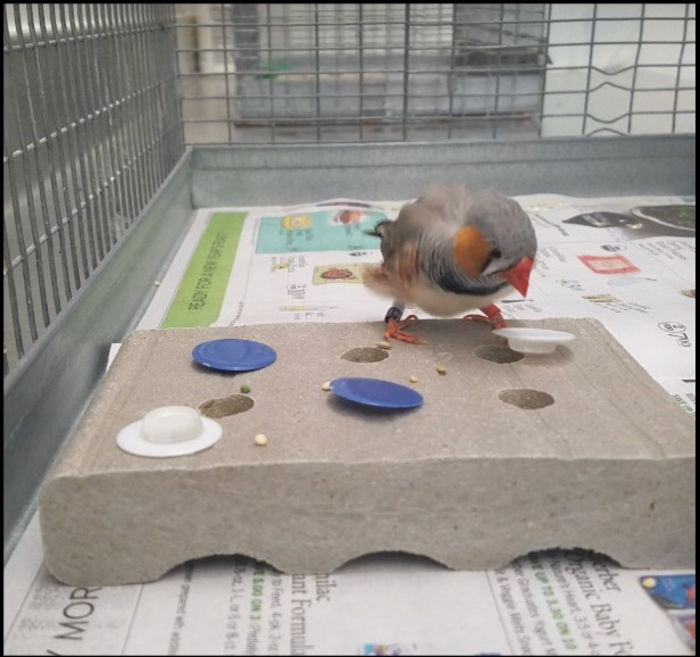There is growing concern that anthropogenic noise has various damaging effects on wildlife in urban environments. Urban noise contains a wide range of frequencies, types of sounds such as from traffic, and varying amplitudes including sounds with rapid onset times that can be startling.

Credit: Florida Atlantic University
There is growing concern that anthropogenic noise has various damaging effects on wildlife in urban environments. Urban noise contains a wide range of frequencies, types of sounds such as from traffic, and varying amplitudes including sounds with rapid onset times that can be startling.
While studies have shown that noise pollution affects cognitive performance in some animal species including birds, a study by Florida Atlantic University is the first to test whether exposure to this noise has any effects on a bird’s beak.
For the study, researchers tested a songbird – the zebra finch (Taeniopygia guttata). Males have a colorful plumage of white, black, gray, orange and brown while females are uniformly gray. Males have bright red beaks while females’ beaks are orange. Their beak ornamentation is a social signal and a secondary sexual trait that can signal a male’s quality and affect female mate preference. Beak color also affects dominance hierarchies in male zebra finches.
Because results from previous studies have yielded mixed results, the FAU researchers conducted two separate experiments to determine the effects of anthropogenic noise on cognition, beak color, and growth in zebra finches. In the first experiment, they tested adult zebra finches on a battery of cognition assays while they were exposed to playbacks of urban noise versus birds tested without noise.
For the second experiment, researchers measured the cognitive performance of adult zebra finches on the same foraging tasks after raising them with consistent exposure to urban noise. They compared their performance to birds raised with exposure to “pink noise” (a type of noise control) or with exposure to the normal sounds of the aviary. They also tracked their growth and the development of their beak coloration during the first 90 days of life, and then tested the birds on the battery of cognition assays once they reached adulthood.
Results of the study, published in the journal Acta Ethologica, showed that urban noises caused the birds to take longer to learn a novel foraging task and to learn an association-learning task. While urban noise exposure during development did not affect growth rate or adult body size, treated males developed less bright beak coloration, and females developed beaks with brighter orange coloration, respectively, than untreated birds.
“Our finding suggest that urban noise exposure may affect morphological traits, such as beak color, which influence social interactions and mate choice,” said Rindy C. Anderson, Ph.D., senior author, an associate professor of biological sciences and director of the Behavioral Ecology and Bioacoustics Lab at FAU’s Davie campus within the Charles E. Schmidt College of Science and a member of the FAU Stiles-Nicholson Brain Institute. “However, the mechanisms by which noise affects beak ornamentation remain unclear. If traffic noise raises corticosterone levels and corticosterone levels affect beak color, then it is possible that stress is mediating the effects of noise exposure on beak ornamentation.”
Findings showed that male finches exposed to normal aviary sounds had beaks that were brighter at day 90 compared to the urban and pink noise groups, while females showed more red hued beaks at day 90 in the urban and pink noise treatment groups. The beaks of juvenile zebra finches are black and begin to change color at about one month of age, typically reaching adult color at about 65 days old. This is likely why the researchers did not detect any effects of urban noise on beak color from measurements taken before the 90-day time point.
“Further research should investigate the effects of beak ornamentation on social hierarchies and mate selection in urban environments, and test whether social interaction in noisy environments can ameliorate negative effects from urban noise on traits such as problem-solving and neophobia or fear of new things,” said Anderson.
Study co-authors are FAU’s Charlie Daria, a graduate student; and Morgan C. Slevin, a doctoral student, both in the Charles E. Schmidt College of Science.
FAU’s Office of Undergraduate Research and Inquiry, Charles E. Schmidt College of Science, and the Department of Biological Sciences provided funding and logistical support for the study.
– FAU –
About Florida Atlantic University:
Florida Atlantic University, established in 1961, officially opened its doors in 1964 as the fifth public university in Florida. Today, the University serves more than 30,000 undergraduate and graduate students across six campuses located along the southeast Florida coast. In recent years, the University has doubled its research expenditures and outpaced its peers in student achievement rates. Through the coexistence of access and excellence, FAU embodies an innovative model where traditional achievement gaps vanish. FAU is designated a Hispanic-serving institution, ranked as a top public university by U.S. News & World Report and a High Research Activity institution by the Carnegie Foundation for the Advancement of Teaching. For more information, visit www.fau.edu.
Journal
acta ethologica
DOI
10.1007/s10211-022-00406-0
Method of Research
Observational study
Subject of Research
Animals
Article Title
Effects of anthropogenic noise on cognition, bill color, and growth in the zebra finch (Taeniopygia guttata)
Article Publication Date
22-Dec-2022




